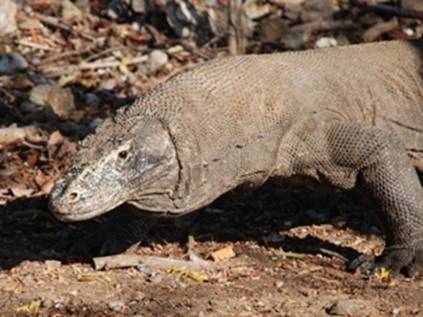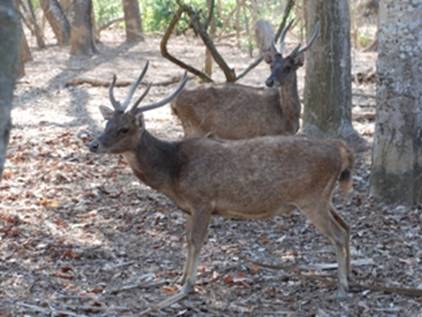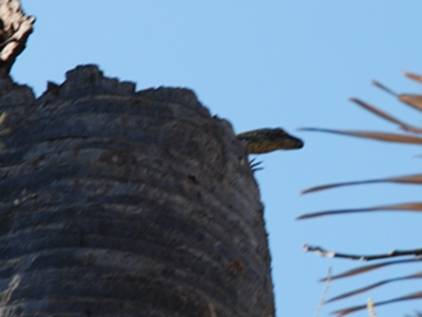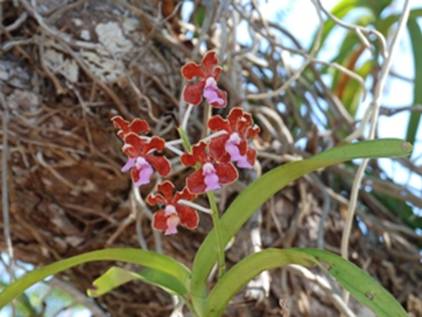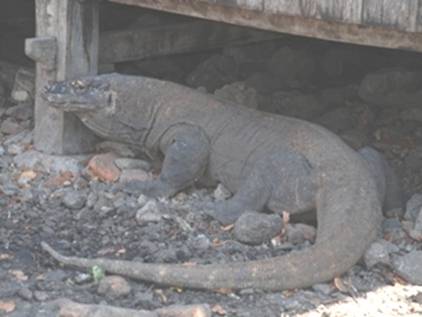Komodo National Park

|
The The establishment of the park which is a world heritage,
site came to late to save the Komodo dragons (or Ora as the locals call them),
on Paradar. The staple diet of the dragons….local deer, were hunted and
shot to extinction by individuals from The national park is home to some 3,500 local people in four
small villages. There are some 2,500 of these giant lizards surviving within
the park. 1,200 of them on Komodo itself. The anchorage for the park, and visitors centre (where all
visitors must report), is in a bay on the SE corner of the Great care needs to be exercised when coming ashore by
dingy, as there is a coral reef that extends some way out from the east of the
jetty. The swell and surge here can also be difficult at times. On arrival, we first had to report to the harbour master.
Pay USD 20 and then have our “Green Book” AKA Cruising permit and
all the other administrative paraphernalia you have to have in this country,
duly checked and noted in their record book. Then you are allowed to pay your
USD 15 per head for the park entrance fee. There were various
“other” charges, designed to lighten the visiting tourists
wallet. Once all done, you are appointed a guide, who complete with his
Dragon taming stick, invites you to determine which of the various walks you
would like to undertake. There is the 30 minute “quickie”,
the one hour, the four hour or the full 17 km all day affair. The latter one is
only open to special “scientific” (and bloody fit) guests. We opted for the four hour tour.
Actually trek would be more accurate. Note we started very early in the morning
to avoid the worst of the midday heat and humidity. This is essential because
it is VERY hot and humid here. After the obligatory safety briefing and some background
chat on the park and the animals, we set of in search of dragons. Within
500 metres we came upon our first fully grown Dragon.
Now a word about our “hosts”. They reach more
than 3 metres in length and weigh in at 90 kilograms. So clearly the worlds
largest lizard. They can run at up to 30 kph, which is very surprising when you
see them lumbering along. They are carnivores. Living on a diet of It is said that with their snake like tongue they can sense
blood and body waste matter from up to 3 km.
A single bite from these creatures is deadly….and not
a nice way to go! It has some 53 different bacteria within its mouth. This
cocktail of bugs is deadly for most mammals and a slow lingering death awaits
after 2 to 3 days of being wounded. They hunt alone, usually at night,
praying on sleeping victims. But, once a fresh meal is “in play”
they stalk it until it dies and then eat as a group, with the others homing in
on the sent of the blood and body wastes. They have massive appetites.
Eating the equivalent of their own body weight per day. They eat everything.
Bones the lot.
Our guide was very well trained and informative. He took us
to a dead palm tree, where perched on the very top was a baby Komodo Dragon.
This one was about 30 cm long and between 1 & 2 years
old. As soon as they hatch, they take to the trees to avoid being eaten by
their parents. Yes, the Komodo is also a sort of cannibal. At this stage in
their development, like most other lizards, they live on Geckos, spiders and
insects, as well as tree living snakes. They only return to earth when their
body weight and gravity gets to the point where they can no longer climb the
trees. The Komodo dragon has an interesting symbiotic relationship
with the Megapod bird. (Yes that is the name…it is not a joke). This bird
looks a bit like a large Ibis, with a long curving beak and long spindly legs.
Beige/brown in colour. It lives on grubs and insects, and finds these by
scratching around in the undergrowth. It likes to breed in the spring, and so
build a huge ground nest from light soil, twigs and dried leaves. Once it has
finished with the nest (where they return each year) the female Dragons come
along and dig a shallow hole in the nest and then lay their eggs in the hole,
before covering them up and guarding them for up to three months. They lay
between 18 and 30 eggs. As soon as these hatch, the dragon abandons the nest
and its every man for himself as far as the off spring are concerned. We were also shown the area where tourists used to come to
watch feeding of the dragons. This was band some time ago as the dragons were
getting lazy and not hunting for themselves. It was also making them very
aggressive and there were a couple of nasty incidents involving tourists. During our walk we saw wild Eagles, Wild Boar (but never
close enough to photograph), a deer that had been bitten by a dragon, but was
still just alive. But no There is also an amazing range of wind birds to be seen and
here as well as fruit bats and some sumptuous wild Orchids, growing on the
larger trees.
After a thoroughly interesting and entertaining, but exhausting
walk. We returned to the visitor reception and more to the point, the
restaurant. We enjoyed scrambled eggs on toast and
As we came back through the adjacent settlement which is for
the National Park employees, we were able to study their houses. On the
previous evening, one of the Dragons had decided to go into one of these
houses, looking for food. The inhabitants quickly left, and apparently it was a
major exercise the rid the house of the dragon. When we went bye, one of the
dragons was enjoying a siesta in the shade by one of these same house. Living
with Dragons? Not for me!
Finally we visited the craft stalls which are adjacent to
the beach and the reception area. There were at least 30 stall holders all
selling pretty much the same stuff. Carved masks, and wooden carvings of
Dragons of various shapes and sizes. All at ridiculously high prices. I
declined to buy anything and then they turned very aggressive and pushy. Any
chance that I might have considered of buying trinkets or mementos went out of
the window at this point. One guy followed us all the way back to the dingy and
I swear would have come out to the boat too had I not insisted he leave us
alone. Another one was asking for medical drugs from our medical kit on board.
Quite an unpleasant experience. That said, one of them dropped the price to one
fifth of what he quoted me at his stall, by the time we were back on the
jetty. So, it clearly was a rip off. We had intended to visit the village
down the coast from here, but some other rally boats had not enjoyed the
experience there due to the pushy and greedy behaviour of the inhabitants. So,
we decided to give that a miss, and decided it was time to move on. We had also taken advice about the best times to catch the
favourable tide, so we were back on the boat and raising the anchor by 1100. WE
then enjoyed an anti clockwise rollercoaster ride around Komodo, its fearsome
tides (in out favour) for the next four hours. We then picked up a NP mooring
buy on Gili Lawa Laut on the NE corner of Komodo. After a quite, well not that quite night, thanks to the
compressors running all night long on the adjacent dive boat. We dropped the
buoy at 0830 on the morning of the 17th October to head west once
again. This time for a bit of pampering and
RnR………………………….. It was a fulfilling experience visiting Komodo. It once
again re-enforced our decision to press ahead with the tour of Nusa Tenggara.
What an amazing and fascinating country it is. Then there was lots more to look forward
to……………….bring it on! |

